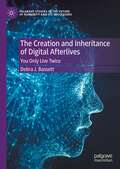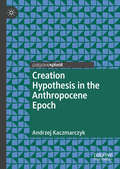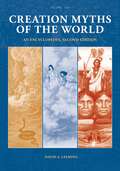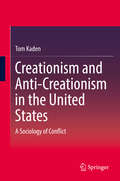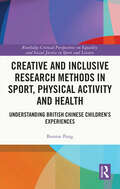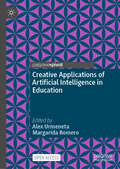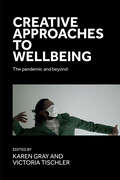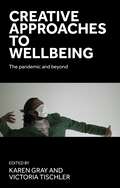- Table View
- List View
Creating Value for Leaders: Balancing the Interests of Customers, Employees, Investors, and the Marketplace
by Gautam MahajanCreating value is the foundation of all business. It’s what sets you apart from your competition, secures long-term customers, and brings distinct meaning to your brand and your stakeholders. Without creating value for your business, your unique offering will be seen as just another commodity in the eyes of your target market. Creating value is in every business leader’s vocabulary and uppermost in their overall strategy. In fact, creating value is the purpose of a company according to the Business Roundtable and the World Economic Forum. That is another key reason why more people want to understand and utilise value creation for their benefit and the good of their stakeholders. Many companies and leaders seek to create value but do not know how to. As a result, they create and destroy value unconsciously. This book shows you how to create value consciously. To create long-term value, organizations need to put in place the mindset, capabilities, and relationships that enable them to meet the needs of their customers and stakeholders. This book makes value creation understood and used by executives and leaders more effectively. The book describes value creation in its various nuances, how it arises, how it is used, and the width and scope of value creation, from how it impacts a company and how that company can become more successful by creating value for customers and other stakeholders. The author also provides tips for CEOs, managers, HR, and other professionals on how to succeed in value creation as a long-term strategy and in day-to-day work. Numerous examples and case studies illustrate the points being made by the author.
Creating Value for Leaders: Balancing the Interests of Customers, Employees, Investors, and the Marketplace
by Gautam MahajanCreating value is the foundation of all business. It’s what sets you apart from your competition, secures long-term customers, and brings distinct meaning to your brand and your stakeholders. Without creating value for your business, your unique offering will be seen as just another commodity in the eyes of your target market. Creating value is in every business leader’s vocabulary and uppermost in their overall strategy. In fact, creating value is the purpose of a company according to the Business Roundtable and the World Economic Forum. That is another key reason why more people want to understand and utilise value creation for their benefit and the good of their stakeholders. Many companies and leaders seek to create value but do not know how to. As a result, they create and destroy value unconsciously. This book shows you how to create value consciously. To create long-term value, organizations need to put in place the mindset, capabilities, and relationships that enable them to meet the needs of their customers and stakeholders. This book makes value creation understood and used by executives and leaders more effectively. The book describes value creation in its various nuances, how it arises, how it is used, and the width and scope of value creation, from how it impacts a company and how that company can become more successful by creating value for customers and other stakeholders. The author also provides tips for CEOs, managers, HR, and other professionals on how to succeed in value creation as a long-term strategy and in day-to-day work. Numerous examples and case studies illustrate the points being made by the author.
Creation: Law and Probability (Routledge Revivals)
by Fraser WattsPublished in 1999. How can we reconcile assumptions about the lawfulness of the universe with provision for chance events? Do the ‘laws of nature’ indicate what absolutely must happen, or just what is most likely to happen? These are important questions for both science and theology, and are explored here in the first in-depth coverage of an important but neglected topic. Including perspectives from prestigious contributions, and published with the backing of the International Society for Science and Religion (ISSR), Creation: Law and Probability employs the disciplines of history and philosophy, as well as cosmology, evolutionary biology, and neuroscience in a fascinating dialogue of faith traditions.
Creation: Law and Probability (Routledge Revivals)
by Fraser WattsPublished in 1999. How can we reconcile assumptions about the lawfulness of the universe with provision for chance events? Do the ‘laws of nature’ indicate what absolutely must happen, or just what is most likely to happen? These are important questions for both science and theology, and are explored here in the first in-depth coverage of an important but neglected topic. Including perspectives from prestigious contributions, and published with the backing of the International Society for Science and Religion (ISSR), Creation: Law and Probability employs the disciplines of history and philosophy, as well as cosmology, evolutionary biology, and neuroscience in a fascinating dialogue of faith traditions.
Creation and Evolution: A Biosemiotic Approach
by Friedrich S. RothschildThe issues surrounding Darwin's theory of evolution as a function of the survival of the fittest have hardly abated since they were initially promulgated about 150 ago. The reason is clear: behind the theory of evolution is a doctrine of structure of organisms that can be explained only by fitting the adaptation to the external world. The older doctrines of creation have been at odds with evolutionism from the outset--sometimes utilizing straight theological arguments and at other times employing sophisticated scientific arguments. Into the breach steps Friedrich S. Rothschild, a trained neurologist, psychologist and physician. On the basis of his researches in comparative embryology, Rothschild argues that the central nervous system of animals as well as humans conveys meaning just like language, and not just a system aimed at adaptation to the external environment. His theory of biosemiotics introduces the concept of inner adaptation. This adaptation to the principal forces assign meaning to life. In monotheistic religions this force is called God. The issue of adaptation is therefore both external and internal, related to growth of the person no less than the environment. This book is intended for those who are interested in life and its varied meanings, to students of sociobiology and medicine as well as those concerned with humanities.
Creation and Evolution: A Biosemiotic Approach
by Friedrich S. RothschildThe issues surrounding Darwin's theory of evolution as a function of the survival of the fittest have hardly abated since they were initially promulgated about 150 ago. The reason is clear: behind the theory of evolution is a doctrine of structure of organisms that can be explained only by fitting the adaptation to the external world. The older doctrines of creation have been at odds with evolutionism from the outset--sometimes utilizing straight theological arguments and at other times employing sophisticated scientific arguments. Into the breach steps Friedrich S. Rothschild, a trained neurologist, psychologist and physician. On the basis of his researches in comparative embryology, Rothschild argues that the central nervous system of animals as well as humans conveys meaning just like language, and not just a system aimed at adaptation to the external environment. His theory of biosemiotics introduces the concept of inner adaptation. This adaptation to the principal forces assign meaning to life. In monotheistic religions this force is called God. The issue of adaptation is therefore both external and internal, related to growth of the person no less than the environment. This book is intended for those who are interested in life and its varied meanings, to students of sociobiology and medicine as well as those concerned with humanities.
The Creation and Inheritance of Digital Afterlives: You Only Live Twice (Palgrave Studies in the Future of Humanity and its Successors)
by Debra J. BassettThis book explores how social networking platforms such as Facebook, Twitter, and WhatsApp ‘accidentally’ enable and nurture the creation of digital afterlives, and, importantly, the effect this digital inheritance has on the bereaved. Debra J. Bassett offers a holistic exploration of this phenomenon and presents qualitative data from three groups of participants: service providers, digital creators, and digital inheritors. For the bereaved, loss of data, lack of control, or digital obsolescence can lead to a second loss, and this book introduces the theory of ‘the fear of second loss’. Bassett argues that digital afterlives challenge and disrupt existing grief theories, suggesting how these theories might be expanded to accommodate digital inheritance. This interdisciplinary book will be of interest to sociologists, cyber psychologists, philosophers, death scholars, and grief counsellors. But Bassett’s book can also be seen as a canary in the coal mine for the ‘intentional’ Digital Afterlife Industry (DAI) and their race to monetise the dead. This book provides an understanding of the profound effects uncontrollable timed posthumous messages and the creation of thanabots could have on the bereaved, and Bassett’s conception of a Digital Do Not Reanimate (DDNR) order and a voluntary code of conduct could provide a useful addition to the DAI. Even in the digital societies of the West, we are far from immortal, but perhaps the question we really need to ask is: who wants to live forever?
The Creation and Interpretation of Commercial Law
by Clayton P. GilletteThis title was first published in 2003. This volume contains essays by prominent commentators on topics in commercial law. It addresses the increasing harmonization of international commercial law and the essays demonstrate different methodologies used in analysing commercial law, such as economic and jurisprudential approaches.
The Creation and Interpretation of Commercial Law
by Clayton P. GilletteThis title was first published in 2003. This volume contains essays by prominent commentators on topics in commercial law. It addresses the increasing harmonization of international commercial law and the essays demonstrate different methodologies used in analysing commercial law, such as economic and jurisprudential approaches.
Creation and Returns of Social Capital (Routledge Advances in Sociology)
by Henk Flap Beate VölkerThe idea of a social capital research program has become increasingly significant within the social sciences. This collection of essays contributes to a theoretical integration as well as standardization of measurement instruments and co-ordination of empirical research on the significance of social capital.
Creation and Returns of Social Capital (Routledge Advances in Sociology)
by Henk Flap Beate VölkerThe idea of a social capital research program has become increasingly significant within the social sciences. This collection of essays contributes to a theoretical integration as well as standardization of measurement instruments and co-ordination of empirical research on the significance of social capital.
Creation Hypothesis in the Anthropocene Epoch
by Andrzej KaczmarczykThis book is a discourse on creation hypothesis in light of new scientific findings made in the 20th and 21st centuries, incorporating sacred texts of different religions. It also addresses the universal phenomena of information and mathematics within this context. The discourse makes an important contribution to the ongoing conversation about creationism, intelligent design, and the problems of science vs. religion.
Creation Hypothesis in the Anthropocene Epoch
by Andrzej KaczmarczykThis book is a discourse on creation hypothesis in light of new scientific findings made in the 20th and 21st centuries, incorporating sacred texts of different religions. It also addresses the universal phenomena of information and mathematics within this context. The discourse makes an important contribution to the ongoing conversation about creationism, intelligent design, and the problems of science vs. religion.
Creation Myths of the World [2 volumes]: An Encyclopedia [2 volumes]
by David A. LeemingThe most comprehensive resource available on creation myths from around the world—their narratives, themes, motifs, similarities, and differences—and what they reveal about their cultures of origin.ABC-CLIO's breakthrough reference work on creation beliefs from around the world returns in a richly updated and expanded new edition. From the Garden of Eden, to the female creators of Acoma Indians, to the rival creators of the Basonge tribe in the Congo, Creation Myths of the World: An Encyclopedia, Second Edition examines how different cultures explain the origins of their existence.Expanded into two volumes, the new edition of Creation Myths of the World begins with introductory essays on the five basic types of creation stories, analyzing their nature and significance. Following are over 200 creation myths, each introduced with a brief discussion of its culture of origin. At the core of the new edition is its enhanced focus on creation mythology as a global human phenomenon, with greatly expanded coverage of recurring motifs, comparative themes, the influence of geography, the social impact of myths, and more.
Creationism and Anti-Creationism in the United States: A Sociology of Conflict
by Tom KadenThis book deals with professional creationist and anti-creationist organizations in America, and describes how the “conflict between science and religion” is the result of the interaction between these two groups. It retraces their history from the 1960s onwards, and identifies crucial turning points that led to new forms of creationism and anti-creationism. It explains their strategies, labels and arguments as effects of this history and structure. Taking a field theoretical approach, the book avoids problems of prior creationism research, making it possible to identify the mechanisms through which creationism generates new strategies, arguments, and media output. The field model is used as an interpretive tool to make sense of some of the most important creationist and anti-creationist publications and media statements.
Creationism in a South Korean Culture: Science, Religion, and the Struggle against Evolution (Routledge Contemporary Asia Series)
by Hyung Wook ParkPark investigates the unexpected success of early Korean creationists, who were mostly scientists, and argues that creationism is not a product of the lack of intelligence or proper scientific education but a consequence of more profound social developments in the twentieth and twenty-first centuries.Known as the religious belief rejecting evolutionary theory, creationism has become a global issue. Although it was often known as a problem unique among fundamentalist Protestants in the United States, it has been appropriated by people with diverse religions around the world, including Asia, Africa, Europe, and South America. Many scientists and educators perceive this dissemination as a threat to modern pedagogy and scholarship, although few of them are aware of its historical and cultural contexts. Through an intensive study of the birth and growth of the anti-evolutionary movement in South Korea during the twentieth and early twenty-first centuries, this book traces an important part of this worldwide movement against evolution. The author argues that South Korean creationism started from the country's past as a developmental state during the Cold War but proliferated further amid subsequent democratization and globalization. Creationism reflected the new identifications of some Korean scientists and engineers with evangelical faith, who actively formed their own domain outside of the state hegemony and authority.This book is a valuable reference for scholars interested in the dynamic interaction between science and religion in East Asia.
Creationism in a South Korean Culture: Science, Religion, and the Struggle against Evolution (Routledge Contemporary Asia Series)
by Hyung Wook ParkPark investigates the unexpected success of early Korean creationists, who were mostly scientists, and argues that creationism is not a product of the lack of intelligence or proper scientific education but a consequence of more profound social developments in the twentieth and twenty-first centuries.Known as the religious belief rejecting evolutionary theory, creationism has become a global issue. Although it was often known as a problem unique among fundamentalist Protestants in the United States, it has been appropriated by people with diverse religions around the world, including Asia, Africa, Europe, and South America. Many scientists and educators perceive this dissemination as a threat to modern pedagogy and scholarship, although few of them are aware of its historical and cultural contexts. Through an intensive study of the birth and growth of the anti-evolutionary movement in South Korea during the twentieth and early twenty-first centuries, this book traces an important part of this worldwide movement against evolution. The author argues that South Korean creationism started from the country's past as a developmental state during the Cold War but proliferated further amid subsequent democratization and globalization. Creationism reflected the new identifications of some Korean scientists and engineers with evangelical faith, who actively formed their own domain outside of the state hegemony and authority.This book is a valuable reference for scholars interested in the dynamic interaction between science and religion in East Asia.
Creative Ageing and the Arts of Care: Reframing Active Ageing
by Elizabeth BrookeCreative Ageing and the Arts of Care makes a case for cultural participation by older adults to enhance the quality of their lives. Building on concepts of adult human development and empowerment, Elizabeth Brooke reframes 'active ageing' to include forms of creative expression and cultural participation crucial to transforming later stages of the life course. Focusing on the micro-level of the experiences of older adults in visual arts, dance, theatre and music, the book showcases multi-perspective case studies compiled from community-based initiatives and care settings carried out in the United States, United Kingdom, Ireland, and Australia to explain creative ageing in practice. Through the analysis of arts forms embedded in theoretical sociological frameworks and the lens of cultural gerontology, the case studies explore and develop theoretical insights about older adults' experiences of artmaking which also contest ageism. The case studies interrelate meso-level interactional processes entailed in art-making and macro-level structural contexts. Drawing out success factors, the author articulates a transferable policy framework and practical recommendations for a multi-level model of creative ageing. Breaking fresh ground by proposing a new conceptual and practical framework promoting 'creative ageing', Elizabeth Brooke ultimately argues that 'active ageing' must be reframed to include cultural participation as an integral domain at the crux of wellbeing. Ultimately, the book demonstrates how quality of life and quality of care, including self-care, coincide by enabling adults to flourish creatively as they age.
Creative Ageing and the Arts of Care: Reframing Active Ageing
by Elizabeth BrookeCreative Ageing and the Arts of Care makes a case for cultural participation by older adults to enhance the quality of their lives. Building on concepts of adult human development and empowerment, Elizabeth Brooke reframes 'active ageing' to include forms of creative expression and cultural participation crucial to transforming later stages of the life course. Focusing on the micro-level of the experiences of older adults in visual arts, dance, theatre and music, the book showcases multi-perspective case studies compiled from community-based initiatives and care settings carried out in the United States, United Kingdom, Ireland, and Australia to explain creative ageing in practice. Through the analysis of arts forms embedded in theoretical sociological frameworks and the lens of cultural gerontology, the case studies explore and develop theoretical insights about older adults' experiences of artmaking which also contest ageism. The case studies interrelate meso-level interactional processes entailed in art-making and macro-level structural contexts. Drawing out success factors, the author articulates a transferable policy framework and practical recommendations for a multi-level model of creative ageing. Breaking fresh ground by proposing a new conceptual and practical framework promoting 'creative ageing', Elizabeth Brooke ultimately argues that 'active ageing' must be reframed to include cultural participation as an integral domain at the crux of wellbeing. Ultimately, the book demonstrates how quality of life and quality of care, including self-care, coincide by enabling adults to flourish creatively as they age.
Creative Agency (Palgrave Studies in Creativity and Culture)
by Dan HarrisThis book offers a socio-cultural examination of contemporary creativity studies. Drawing heavily on posthumanist, new materialist and affective theoretics, the author argues in favour of an expansive and sustainable approach to creativity which contributes to an emergent ‘creativity studies’ inter-discipline. It seeks to establish a broader consideration of creativity in socio-culture, that extends beyond, or indeed refutes, the narrowing aperture of entrepreneurship and innovation as synonyms for creativity in economic, cultural and educational contexts and discourses. Drawing on multiple case studies of creative relational and creative ecological empirical research, this book integrates a concern for personal, planetary and geo-political collaboration, as an antidote for ‘innovation for innovation’s sake’.
Creative and Inclusive Research Methods in Sport, Physical Activity and Health: Understanding British Chinese Children’s Experiences (Routledge Critical Perspectives on Equality and Social Justice in Sport and Leisure)
by Bonnie PangThis book demonstrates how creative research methods can be used to better understand the experiences of children, particularly in the context of sport, physical activity and health. Extending recent developments in arts-based methods, mobile digital ethnographic methods, participatory visual methods and autoethnography in research with children, the book focuses on British Chinese children – an often-neglected group in research studies – providing new perspectives on diversity and inclusion, innovative research methods and the Chinese diaspora. The book draws on concepts from health and physical education, sport, sociology, and psycho-social studies to shed new light on social dynamics, cultural diversities and contextual changes in British Chinese children’s health-related experiences. It shows how globalisation and international mobility has complicated diversity and difference in the Chinese diaspora, and how creative research methods and reflexivity can be powerful tools for unlocking our understanding of children’s everyday lives. This is fascinating and useful reading for any researcher or advanced student with an interest in innovative research methods, sport, physical activity, health, migration and diaspora studies, childhood and youth studies.
Creative and Inclusive Research Methods in Sport, Physical Activity and Health: Understanding British Chinese Children’s Experiences (Routledge Critical Perspectives on Equality and Social Justice in Sport and Leisure)
by Bonnie PangThis book demonstrates how creative research methods can be used to better understand the experiences of children, particularly in the context of sport, physical activity and health. Extending recent developments in arts-based methods, mobile digital ethnographic methods, participatory visual methods and autoethnography in research with children, the book focuses on British Chinese children – an often-neglected group in research studies – providing new perspectives on diversity and inclusion, innovative research methods and the Chinese diaspora. The book draws on concepts from health and physical education, sport, sociology, and psycho-social studies to shed new light on social dynamics, cultural diversities and contextual changes in British Chinese children’s health-related experiences. It shows how globalisation and international mobility has complicated diversity and difference in the Chinese diaspora, and how creative research methods and reflexivity can be powerful tools for unlocking our understanding of children’s everyday lives. This is fascinating and useful reading for any researcher or advanced student with an interest in innovative research methods, sport, physical activity, health, migration and diaspora studies, childhood and youth studies.
Creative Applications of Artificial Intelligence in Education (Palgrave Studies in Creativity and Culture)
by Alex Urmeneta Margarida RomeroThis open access book explores the synergy between AI and education, highlighting its potential impact on pedagogical practices. It navigates the evolving landscape of AI-powered educational technologies and suggests practical ways to personalise instruction, nurture human-AI co-creativity, and transform the learning experience. Spanning from primary to higher education, this short and engaging volume proposes concrete examples of how educational stakeholders can be empowered in their AI literacy to foster creativity, inspire critical thinking, and promote problem-solving by embracing AI as a tool for expansive learning. Structured in three parts, the book starts developing the creative engagement perspective for learning and teaching to then present practical applications of AI in K-12 and higher education, covering different fields (teacher education, professional education, business education) as well as different types of AI supported tools (games, chatbots, and AI assisted assessment). It also delves into the ethical considerations, policy implications, and the central role educators play in harnessing the power of an AI informed educational experience.
Creative approaches to wellbeing: The pandemic and beyond (The pandemic and beyond)
by Karen Gray and Victoria TischlerA compilation of case studies illustrating how arts, culture and other community assets were used by individuals and communities to cope and develop resilience during the Covid-19 pandemic, demonstrating valuable lessons that might help us develop resilience in similar future crises. Threaded through all the contributions, readers will discover a focus on the experiences and voices of those marginalised during the pandemic, because of their lived experiences of structural inequalities, or due to mental or physical ill-health or age. These are difficult and complex topics, and there are vital lessons here for policy and for practice in the arts and for provision of health and care.
Creative approaches to wellbeing: The pandemic and beyond (The pandemic and beyond)
by Victoria Tischler Karen GrayA compilation of case studies illustrating how arts, culture and other community assets were used by individuals and communities to cope and develop resilience during the Covid-19 pandemic, demonstrating valuable lessons that might help us develop resilience in similar future crises. Threaded through all the contributions, readers will discover a focus on the experiences and voices of those marginalised during the pandemic, because of their lived experiences of structural inequalities, or due to mental or physical ill-health or age. These are difficult and complex topics, and there are vital lessons here for policy and for practice in the arts and for provision of health and care.



